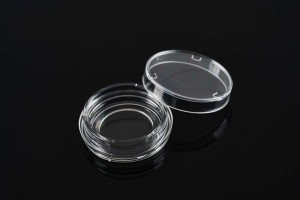What is a Confocal Culture Dish?
The confocal culture dish is a laboratory tool that integrates the features of a confocal microscope and a culture dish, designed to provide high-resolution observation and image acquisition of living cells.
- Structure and properties
- Transparent bottom: The confocal culture dish is designed with a transparent bottom, allowing researchers to directly observe the growth and activity of cells in the culture dish through a microscope.
- Optical design: The device adopts an optimized optical system to ensure higher imaging quality, thereby providing clear information on cell structure and intracellular dynamics.
- Cell friendly: Confocal culture dishes provide an environment conducive to cell growth, maintaining the physiological state of cells, making them more suitable for real-time observation and analysis.
- Application areas
- Biomedical research: Confocal culture dishes can be used to study cell behavior, subcellular structures and dynamic processes, providing key information for biomedical research.
- Drug research and development: In drug research and development, confocal culture dishes can be used to evaluate the impact of drugs on cells, monitor cell responses in real time, and accelerate the discovery and evaluation process of new drugs.
- Cell Biology: Confocal culture dishes are widely used to conduct in-depth studies of basic biological processes such as cell cycle and cell signaling.
-
Application areas
- Cell pre-treatment: Proper cell culture and labeling techniques are required before conducting experiments in confocal dishes to ensure cell health and observability.
- Drug research and development: In drug research and development, confocal culture dishes can be used to evaluate the impact of drugs on cells, monitor cell responses in real time, and accelerate the discovery and evaluation process of new drugs.
- Cell Biology: Confocal culture dishes are widely used to conduct in-depth studies of basic biological processes such as cell cycle and cell signaling.
- Instructions
- Cell pre-treatment: Proper cell culture and labeling techniques are required before conducting experiments in confocal dishes to ensure cell health and observability.
-Microscope setup: Using a confocal microscope, adjust the appropriate parameters to obtain high-resolution images.
- Data acquisition: Through confocal culture dishes, real-time or static images can be acquired to record and analyze various characteristics and behaviors of cells.
-
Advantages and Challenges
- Advantages: Confocal culture dishes have the advantages of high resolution, real-time observation, and multi-parameter imaging, providing comprehensive cell information for research.
- Challenges: However, the high cost of equipment and the high level of expertise required can pose a challenge for some research laboratories.
-
Future direction
-Technical improvements: In the future, confocal culture dishes may undergo technological improvements to increase imaging speed, reduce equipment costs, and make them more widely used in different research fields.
- Application expansion: With the continuous development of technology, the application fields of confocal culture dishes may be further expanded to cover more life science and medical research directions.
As advanced cell observation tools, confocal culture dishes play an important role in biomedical research, providing scientists with the opportunity to gain in-depth understanding of the internal structure and behavior of cells. By combining the properties of confocal microscopy and culture dishes, researchers can gain a more comprehensive understanding of the physiological processes of cells and promote scientific advancement.
Post time: Nov-17-2023


